Laying linoleum on a wooden floor: preparing the base and laying on glue
Linoleum is one of the most popular flooring. And this is not surprising. This material is wear-resistant, hygienic, resistant to various types of influences, has an affordable price. Thanks to a wide range of colors and patterns, linoleum harmoniously fits into many interior styles. It can be laid on almost any foundation - the only thing is that it should be perfectly prepared. A reliable base for linoleum can only be a smooth, clean and dry surface. So if you plan to lay linoleum on a wooden floor, get ready for a large amount of work. Why? It is no secret that one of the key properties of PVC coatings in rolls is high elasticity. And this means that it will easily repeat the shape of all the flaws of the base. Just imagine how the linoleum floor will look ugly, from the “manifest” seams and cracks between the boards.
Content
Types of linoleum - which is better to lay on a tree?
Depending on the raw materials used for the manufacture of linoleum, it is divided into various types.
- Polyvinyl chloride linoleum made from polymeric material. It can be without a base, or maybe on a foam, fabric or heat insulating base.
- Foamed linoleum is four layer. This coating provides good heat and sound insulation, in addition, it is durable and strong, but not flexible enough. Suitable for rooms with high humidity and traffic.
- Linoleum on a fabric basis has two layers: the bottom is fabric, the top is protective. The coating is very plastic, durable.
- Linoleum on a heat and sound insulating basis has a bottom layer of felt or foam reinforced synthetic material. The top layer is a polyvinyl chloride film.
- Linoleum without a support has a uniform structure and is resistant to abrasion, moisture.
- Alkyd linoleum made from alkyd resins with mineral fillers. The base can be both from natural and synthetic materials. It has a drawback - not too plastic, prone to the formation of cracks and creases.
- Rubber linoleum - its lower layer is made of a mixture of bitumen and crushed recycled rubber, the upper one is their colored rubber. It is characterized by high ductility and water resistance, used most often in industrial and industrial premises.
- Colloxyl linoleum - coating based on nitrocellulose. Flexible enough, fireproof with a peculiar shine.
Any of these species boasts a variety of colors, patterns and textures. The drawing applied to the base is covered with a film, the wear resistance of linoleum and its cost depend on the thickness of which. The higher the wear resistance - the wider the scope of the coating. Properly selected flooring with high wear resistance will be appropriate not only in the apartment, but also in public buildings and industrial workshops, it serves for a long time and effectively.
Proper preparation of the base for laying
So, before you is a wooden surface that has served its age, or parquet. What do you need to do first? Of course, to decide how such a foundation is better prepared.And this requires a thorough examination.
If the details of the floor structure are not affected by mold and have only minor flaws, then you can do this:
- fasten all planks / boards;
- remove the "elevation" of the coating with a planer or grinder;
- drown the hats of nails and screws, putty the resulting recesses;
- to fill cracks, chips, and also cracks between floorboards with a special composition. It is recommended to fill wide slots with narrow, specially prepared slats;
- sand the surface.
If the wooden floor is unevenly worn, there are obviously defective floorboards, the best solution would be to lay sheets of moisture-proof plywood on it. The material is attached to the base with self-tapping screws, after which, like the above algorithm, all the hats are “hidden”; the surface in places where it is necessary is putty and then polished. Laying linoleum on plywood, as practice shows, is subsequently as easy and trouble-free as possible.
Topic article: Aligning the wooden floor with plywood: all about laying plywood on a wooden base
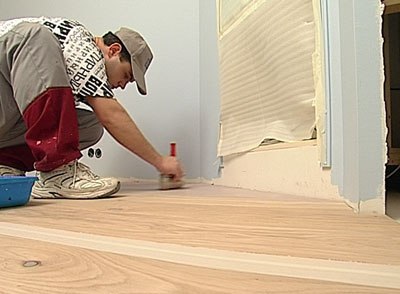
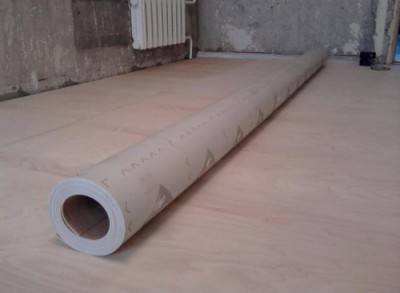
After you carry out all the necessary manipulations with the base and thoroughly clean it, you can begin further work.
Conditions for successful installation
The temperature in the rooms in anticipation of the installation of the coating should be stable for at least 48 hours. At the same time, it is desirable that it exceeds 18 degrees. The temperature of the substrate should not fall below the mark of 15 degrees. Recommended humidity is 40-60%.
Before laying linoleum on a wooden floor, it is necessary to allow the material to acclimatize in the room. Usually at this "stage" requires at least 24 hours. Avoid dropping the cover, make sure that it does not wrinkle.
Also pay attention to such points:
- if you have to work with several rolls within the same room, you need to make sure that they are from the same batch. Docking of the material of the same color, but from different batches can lead to visual imbalance in the seam area;
- It is recommended to lay the PVC coating in the reverse way - that is, the cut canvases should be in contact with each other with the "same" sides. This is necessary, again, to avoid color differences. True, there are exceptions to this rule - natural linoleum and a coating with a wooden pattern always lie in the same direction.
Worth to know! The different concentration of color pigments along the long edges of the roll is due to the technological features of PVC production.
Technology of laying linoleum coating
You can lay linoleum on a wooden floor in the following ways:
- No gluing. This method is the easiest, but not reliable. Suitable only for small rooms up to 12 square meters. Its essence lies in the fact that a carefully leveled coating is simply pressed along the perimeter by skirting boards.
- With fixing on double-sided tape. This installation technology provides a longer operation of the material. The adhesive tape is glued first around the perimeter of the room, and then in the form of a lattice with a side of about 50 centimeters - over the entire surface of the floor. Protective paper film is removed from the adhesive tape only when linoleum is directly bonded. And not all at once, but meter by meter, as the workflow progresses. Each surface area is well smoothed.
- With a glue fit. The most durable option, and if the room is large - then the only reasonable one.
Consider the adhesive laying of linoleum on a wooden base in more detail. Work execution order:
- mark and cut linoleum with a margin of about 5 centimeters for each side. After the linoleum is properly laid down in the room, all excess material can be “eliminated”;
- wrap the prepared canvas with the base up, while freeing half the area of the rough surface for applying adhesive;
- draw on the base along the curled edge with a pencil at risk - this will be the border of the glue
- armed with a notched trowel, apply glue to the base (observe the boundary);
- having passed the required period of time specified in the adhesive instructions, lay the PVC coating on the “fixing” layer and carefully smooth (roll) the surface - first by hand, and then using a roller. It is necessary to roll the coating first in the transverse direction, and then in the longitudinal;
- it is also necessary to do with the second half of the canvas.
If the room is large, you probably have to work with two, or even three sheets of linoleum. This of course complicates the task a little, but the whole principle remains unchanged - first we glue and press one half of the canvas, then the second. Just remember that each subsequent sheet should overlap the previous one (about 2 centimeters). This allows both edges to be cut at the same time, resulting in perfectly matching seams.
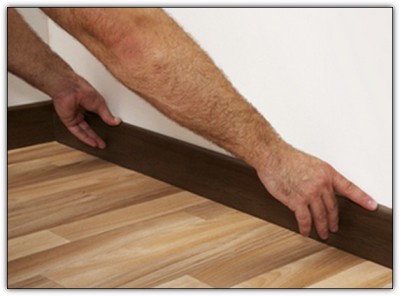
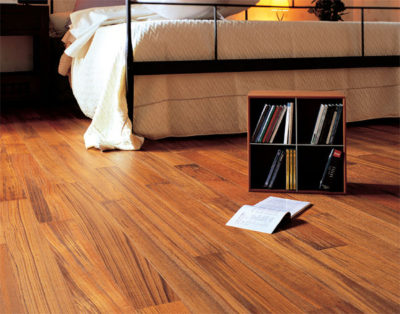
Jointing is carried out two to three days after linoleum flooring. Produce it with a long metal ruler and a special sharp knife. The resulting seams are cleaned of the protruding composition and pressed with a board and cargo until completely dry.
If the canvases of the material were glued really neatly, the seams will be almost invisible. But their complete isolation does not hurt. To do this, use cold or hot welding. The most durable mechanical joint is obtained by hot welding, but cold is usually used in everyday life. This is because to work with it does not require special equipment and special skills.
How to care for linoleum?
To increase the life of the linoleum coating, care must be taken not to neglect it. Do not use active cleaning agents for cleaning - from them the surface of the material crackes and dims. For cleaning, use either special compounds or take care of the floor “classically” - wash it with a simple damp cloth.
Topic article: Linoleum Care - Operating Tips
You can protect linoleum from premature aging with mastics and polishes. To avoid scratches and breaks in the coating, it is advisable to wear special “caps” made of soft material on the furniture legs.

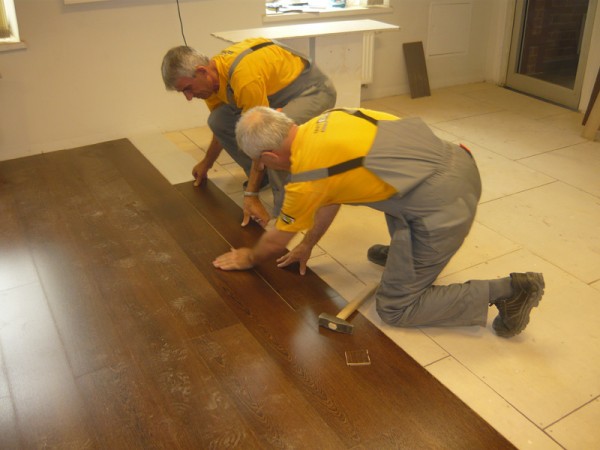

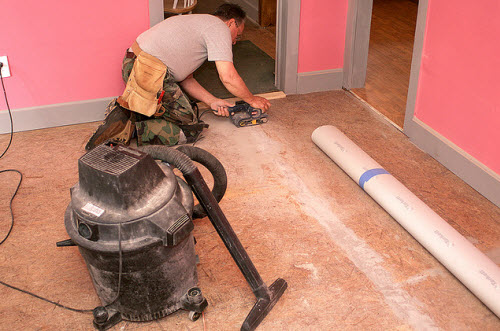
4 comments